West Hartford’s Town Green Rededicated as ‘Unity Green’

Audio By Carbonatix

From left: Adrienne Billings-Smith, Rosemarie Tate, Gail Crockett, Tammy Exum, Carol Anderson Blanks, Judy Casperson, and Lorna Thomas-Farquharson at the dedication of Unity Green on June 20, 2021. Photo credit: Ronni Newton
As West Hartford’s weekend of Juneteenth celebration concluded Sunday, members of the community gathered as the town green was officially renamed ‘Unity Green.’
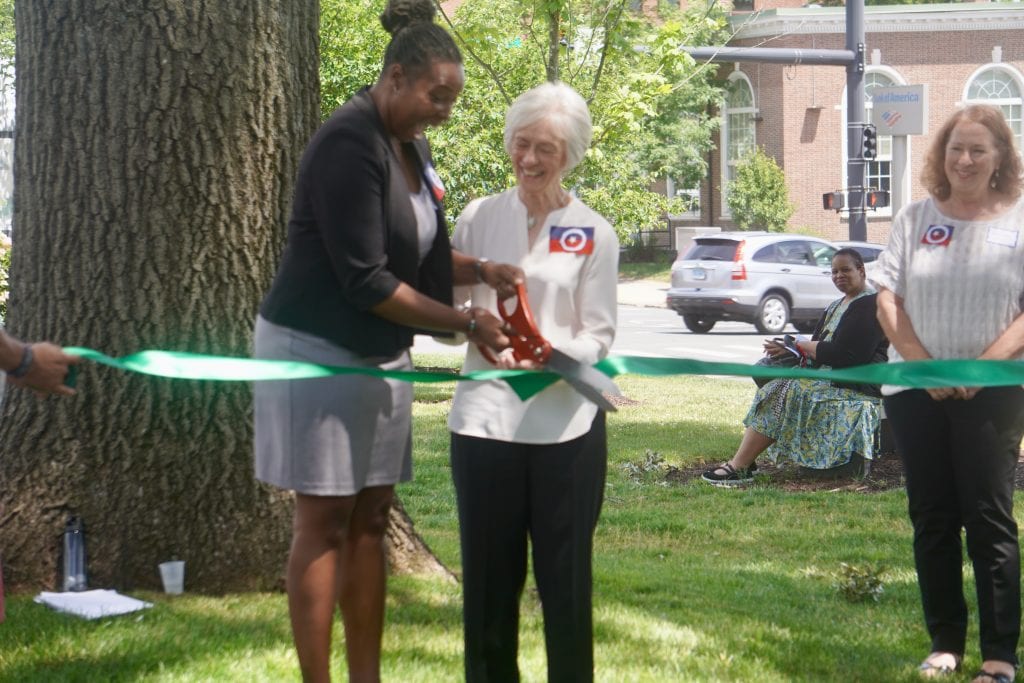
Adrienne Billings-Smith and Dottie Stone – a direct descendent of Timothy Goodman, the former namesake of West Hartford’s town green – cut the ribbon for the official dedication of Unity Green on June 20, 2021. At right is former First Church historian Barbara Lewis. Photo credit: Ronni Newton
By Ronni Newton
West Hartford’s second annual Juneteenth celebration, held over the weekend of June 19-20, 2021, was full of joy juxtaposed by serious messages and actions, with the observation culminating late Sunday morning as a crowd gathered for the rededication of the town’s green as Unity Green.
West Hartford’s town green – that narrow triangle of land that splits the northbound and southbound lanes of South Main Street just south of Farmington Avenue and is the longtime site of banners and public gatherings – had previously been named Goodman Green, in honor of Timothy Goodman, who deeded it to First Church, which in turn has leased the land to the town since 1924. Recent research into the town’s history conducted as part of the Witness Stones project brought to light the fact that, along with some of West Hartford’s other prominent families for whom roadways and buildings have been named, Goodman was, indeed, a slaveholder.
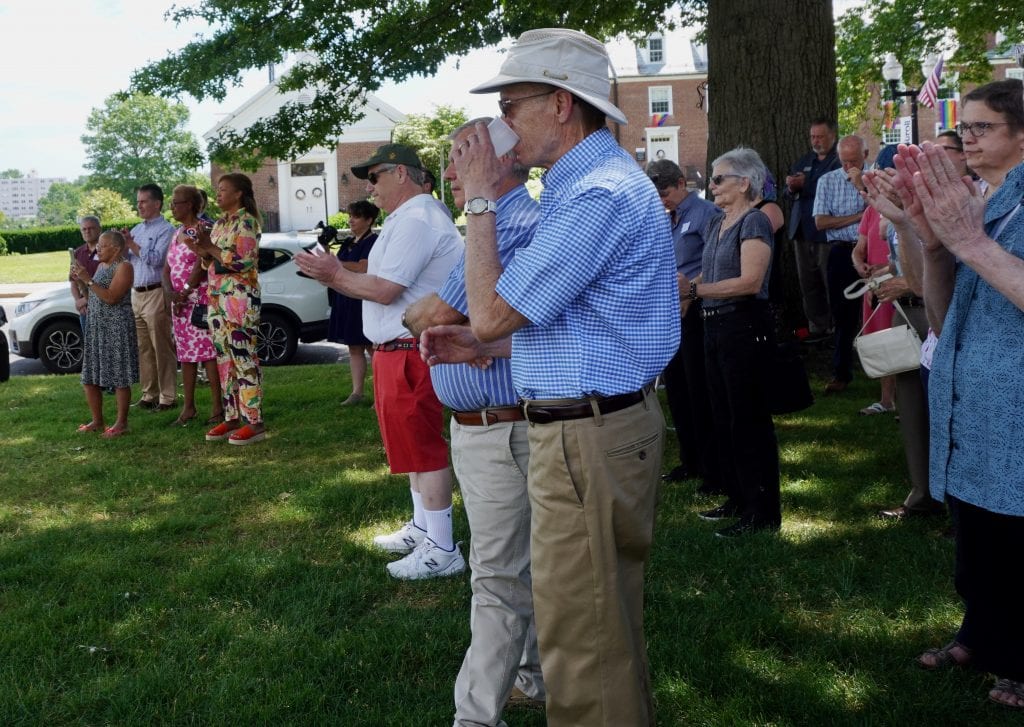
Members of the community gather for the dedication of West Hartford’s Unity Green. June 20, 2021. Photo credit: Ronni Newton
The town’s inaugural Juneteenth celebration, on June 19, 2020, was held on what was still called Goodman Green, but resident Adrienne Billings-Smith, founder and president of Concerned Parents of Color, realized the irony of celebrating Juneteenth in that particular spot.
She approached First Church, and worked with the church community over the course of several months, as they underwent a discovery and reflection. The congregation strongly supported the change, approving it by a vote on Nov, 29, 2020.
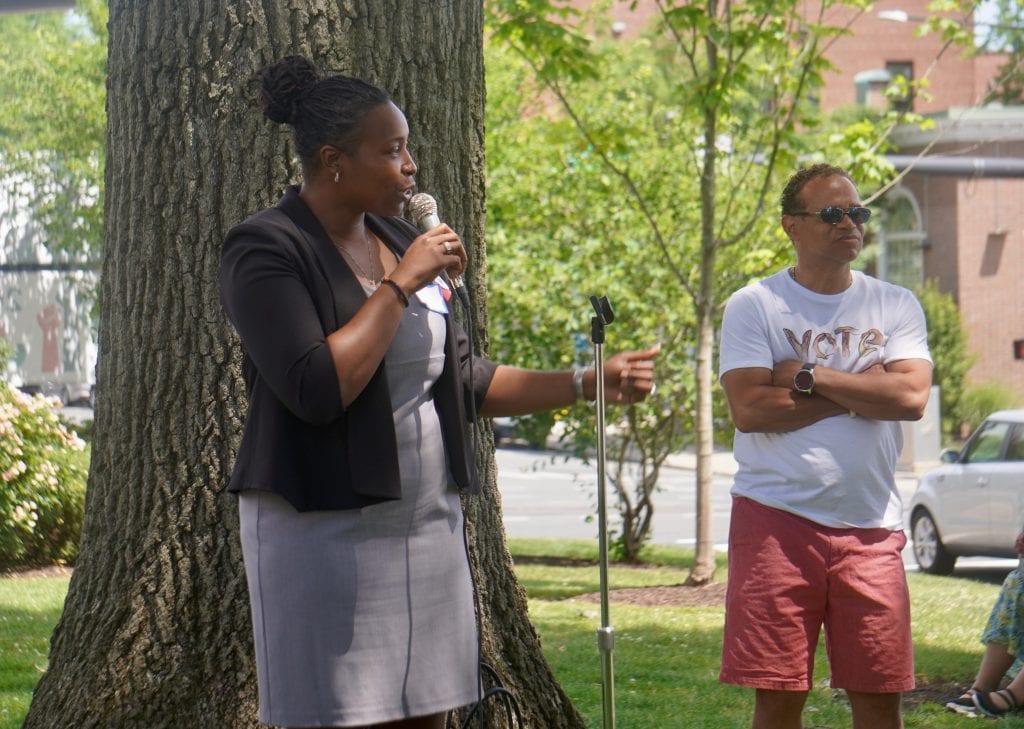
Adrienne Billings-Smith, who first approached First Church about renaming the town’s green, speaks at the dedication on June 20, 2021. At right is her Vice President of the Concerned Parents of Color, Geeno Gordon. Photo credit: Ronni Newton
The dedication of Unity Green was celebrated Sunday during the church service, as Rev. Erica Wember Avena’s sermon (see PDF below) touched on the long history of the church, injustice, and the chance to create a legacy of change rather than just accepting that something is part of history.
“Adrienne Billings-Smith pointed out that there are people in this community who are stricken to know that the name of a slaveholder is reflected in our public space,” Avena said. “And I have heard her say that she is not asking us to move mountains. But if everyone could pick up and move one rock … the mountain of injustice will change shape entirely …”
At the dedication ceremony, Avena led a prayer. “We are mindful of the generations of people who have walked here before us, we honor their lives, we know something of their struggles. We are inheritors of their legacy …” she said. “As we rename this space today, we do so both with appreciation of what has come to us from the past, positive and good, and what we know of the past that has institutionalized oppression, even unto our very day.
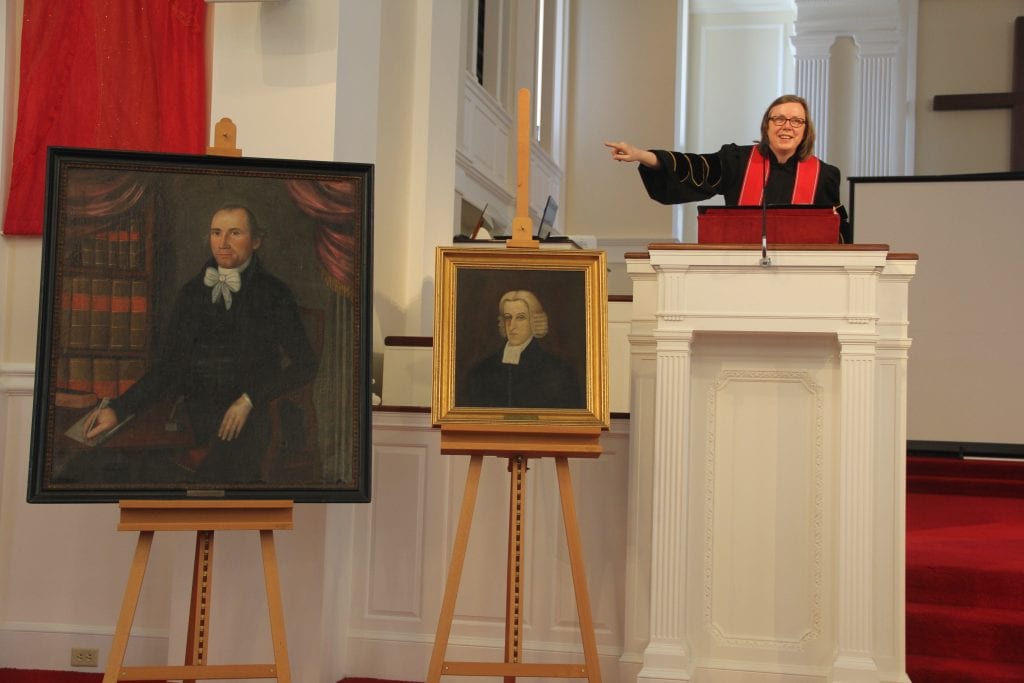
Rev. Erica Wimber Avena on June 20, 2021 pointing out portraits of third pastor of First Church West Hartford Nathan Perkins (circa 1812), and first pastor Benjamin Colton. Courtesy of First Church.
“Let this be a turning point. Let us work together to welcome all, to respect each person’s humanity, to listen to the outsider, to honor the meek,” Avena said.
Barbara Lewis, First Church’s former historian, and a member of the Unity Green renaming committee, said the church began a period of discovery and reflection when asked by Billings-Smith about renaming the town green.
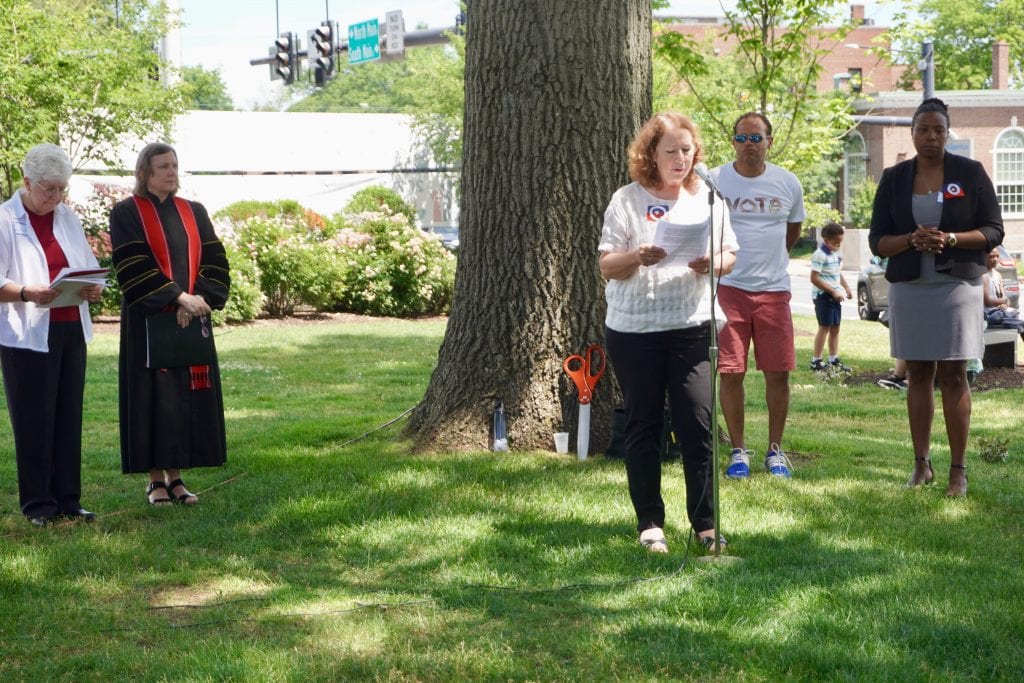
Barbara Lewis, former historian of First Church West Hartford speaks at the dedication of West Hartford’s Unity Green. June 20, 2021. Photo credit: Ronni Newton
“We hope to better understand this history as more research provides a clearer picture,” she said, noting the research undertaken by Tracey Wilson, Liz Devine, and Denise deMello through the Witness Stones project. “We are so very grateful to Adrienne for engaging the congregation in this difficult conversation about acknowledging our past involvement with slavery.”
Unity Green will be a place to foster and embrace unity, for a much more just and inclusive future, Lewis said. “This is not the culmination of a one-and-done project, but the beginning of a collaborative effort.”
Billings-Smith said she worked with Geeno Gordon, vice president of Concerned Parents of Color, to brainstorm about the new name for the green. She said she’s so happy with the name chosen and approved by the congregation – a name that signifies “faith, activism, history, and leadership mean something. We partner together, we are all one in this work together.”
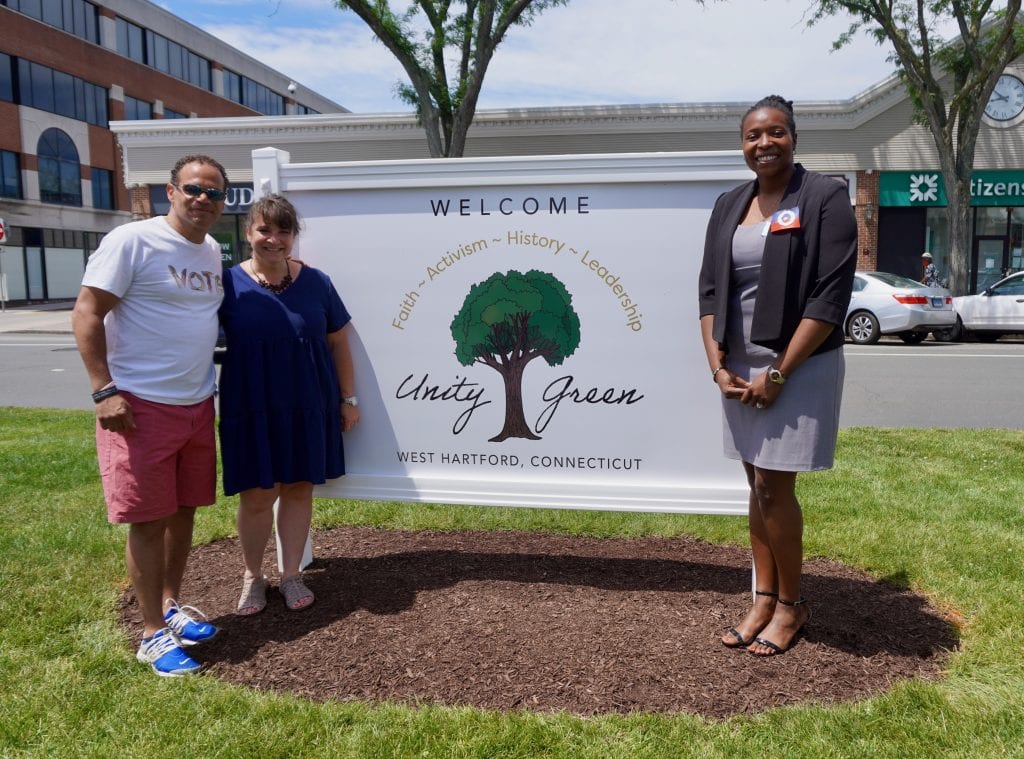
Adrienne Billings-Smith (right) stands in front of the Unity Green sign with Geeno Gordon, vice president of Concerned Parents of Color and Jill Gavalis, the graphic designer who designed the logo. Photo credit: Ronni Newton
Carol Anderson Blanks, a member of West Hartford’s Town Council, thanked all who made Juneteenth possible.
“I’m standing here today on behalf of the mayor and Town Council … as we prepare to dedicate this green to the people of this town, we also memorialize the enslaved men, women, and children – men, women, and children treated as property and listed as assets … by others who claim to be owners human beings,” said Blanks.
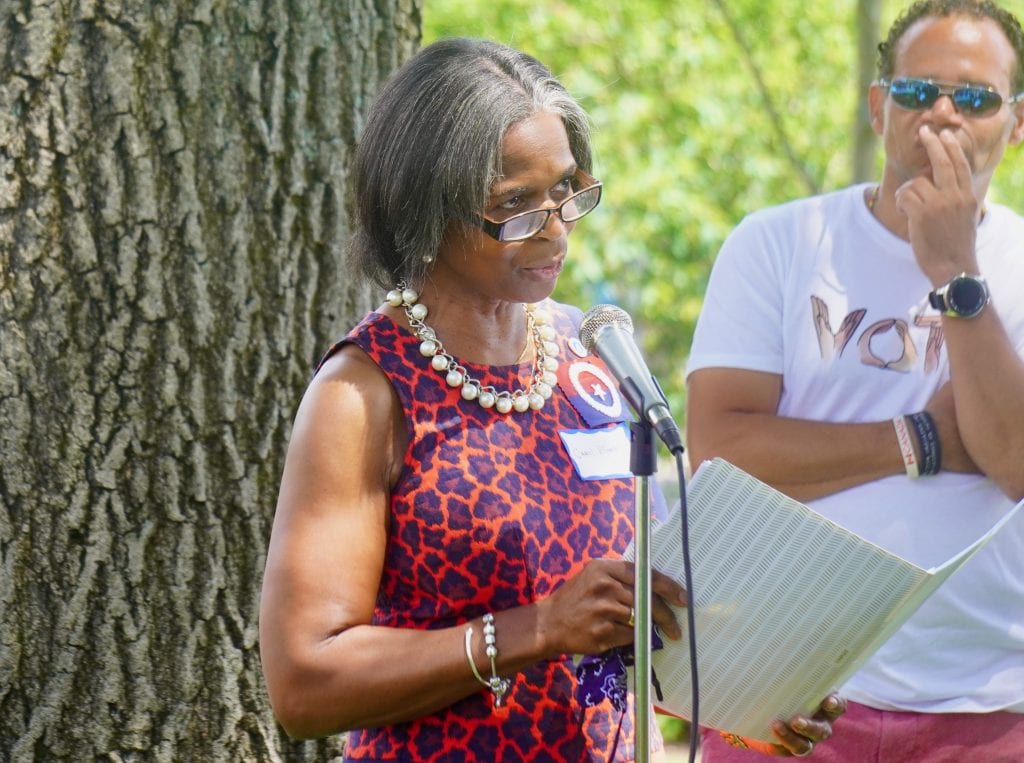
Town Council member Carol Anderson Blanks speaks at the dedication of West Hartford’s Unity Green. June 20, 2021. Photo credit: Ronni Newton
“We gather here on this green to right a wrong of our town’s history.”
The Town Council’s job is to create policy, and although the community has come a long way, “we have a long road ahead of us,” Blanks said. “Each of us here today has the power to be a change agent,” she said, urging all to pledge to be an active participant in the fight against hate, racism, discrimination, and social injustice.
The ceremony ended with a singing of the first verse of Amazing Grace, a hymn Blanks said was written by a slave trader who later became an abolitionist. “Hypocrite or prophet? … The power to change is real, and we can do this together.”
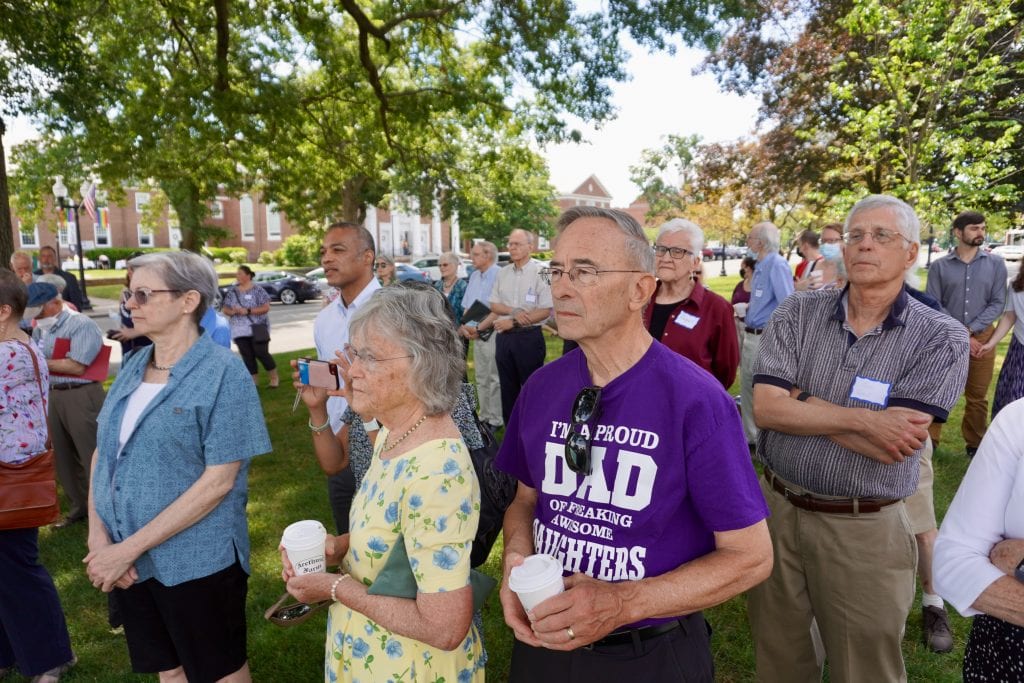
Members of the community gather for the dedication of West Hartford’s Unity Green. June 20, 2021. Photo credit: Ronni Newton
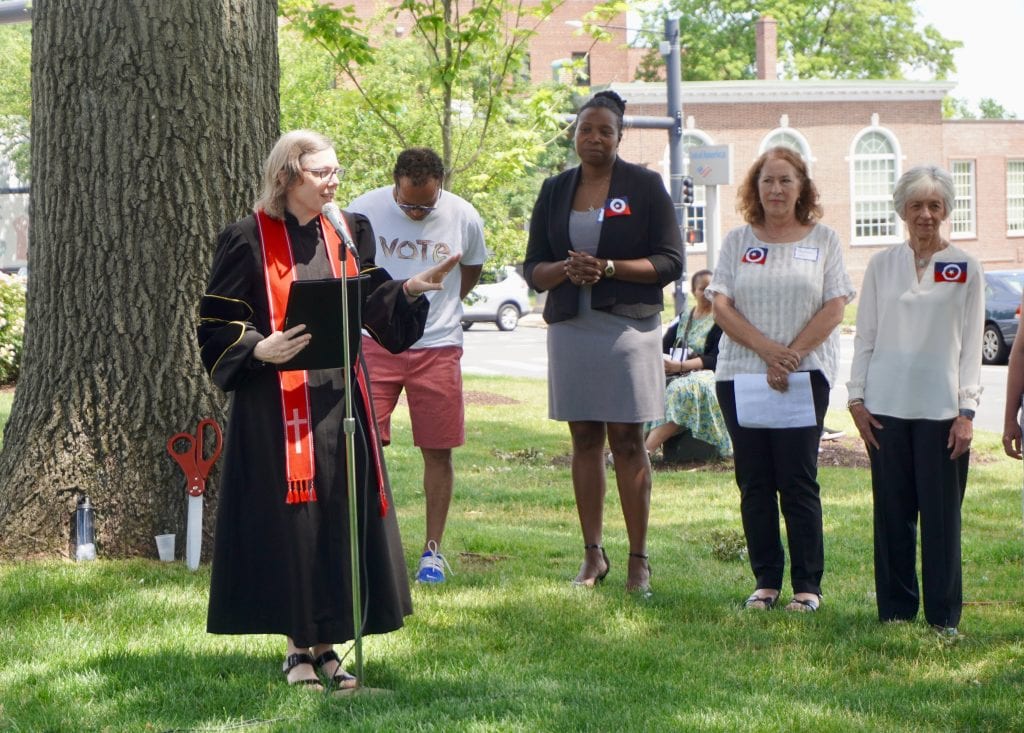
Rev. Erica Wimber Avena of First Church West Hartford speaks at the dedication of West Hartford’s Unity Green. June 20, 2021. Photo credit: Ronni Newton
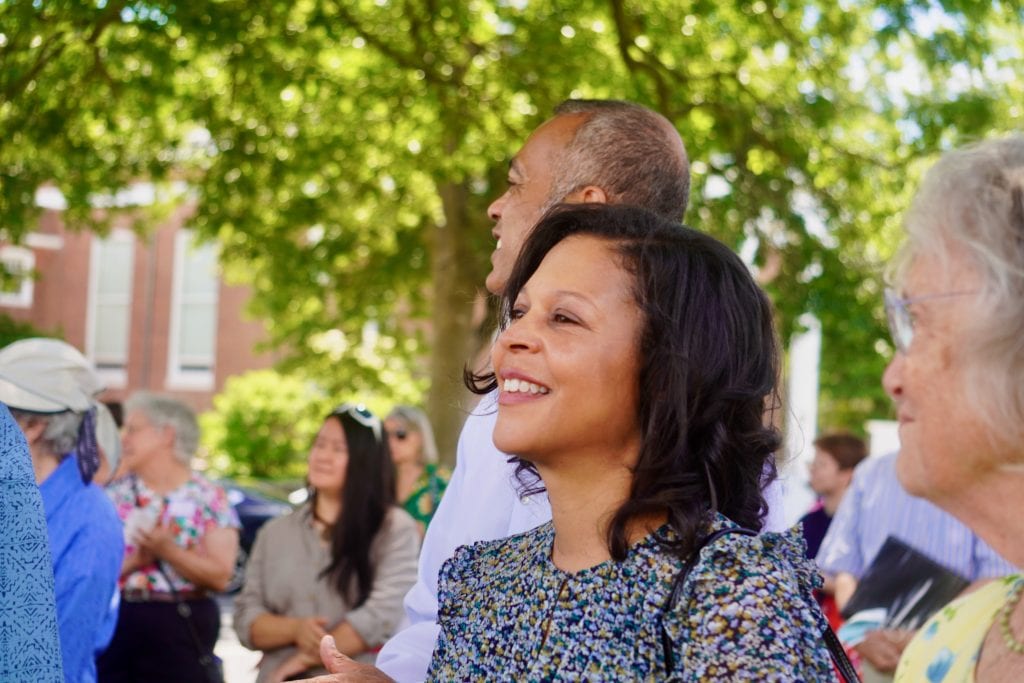
Members of the community gather for the dedication of West Hartford’s Unity Green. June 20, 2021. Photo credit: Ronni Newton
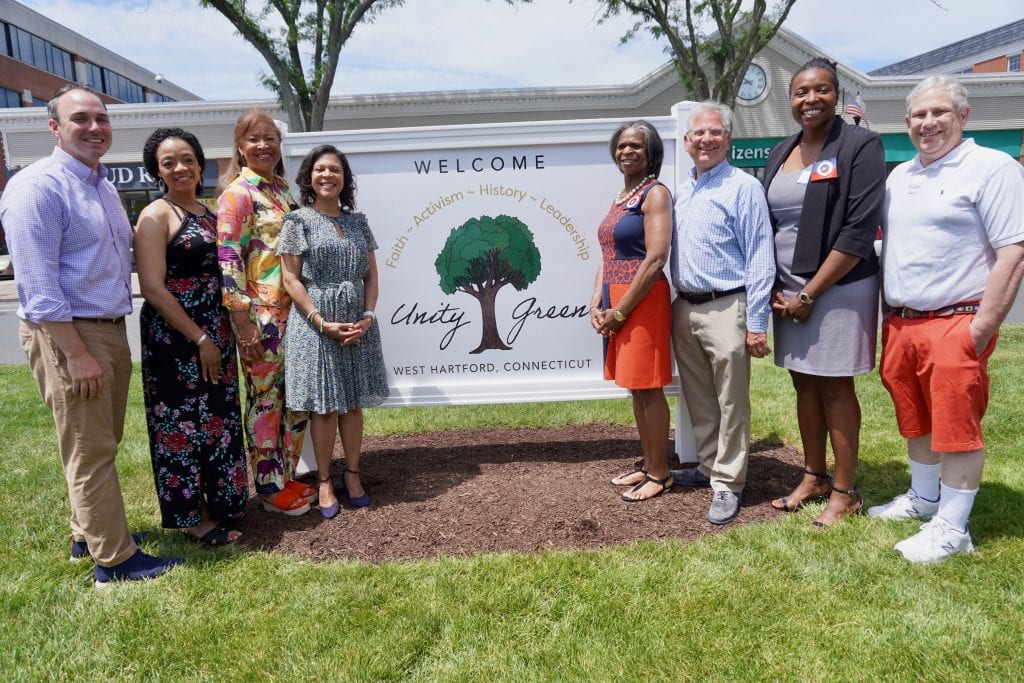
From left: Liam Sweeney, Lorna Thomas-Farquharson, Judy Casperson, Tammy Exum, Carol Anderson Blanks, Ben Wenograd, Adrienne Billling-Smith, and Leon Davidoff at the dedication of West Hartford’s Unity Green. June 20, 2021. Photo credit: Ronni Newton
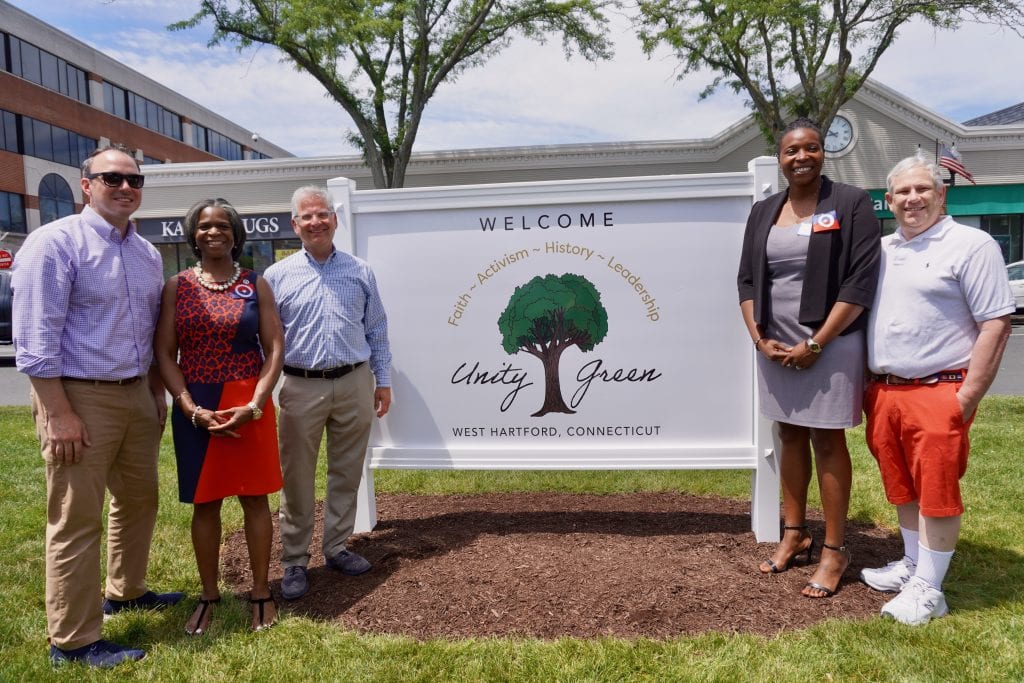
Democratic Town Council members at the dedication of Unity Green include (from left) Liam Sweeney, Carol Anderson Blanks, Ben Wenograd, and Deputy Mayor Leon Davidoff, as well as Adrienne Billings-Smith (second from right) who provided the impetus for the renaming of the town’s green. Photo credit: Ronni Newton
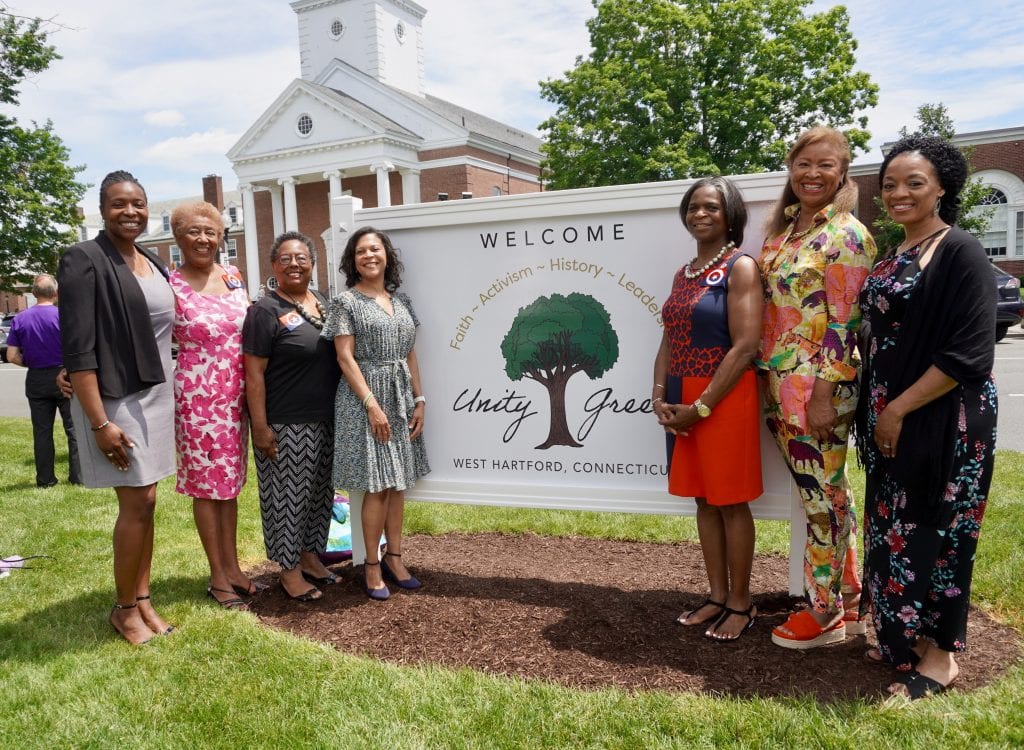
From left: Adrienne Billings-Smith, Rosemarie Tate, Gai Crockett, Tammy Exum, Carol Anderson Blanks, Judy Casperson, and Lorna Thomas-Farquharson at the dedication of Unity Green on June 20, 2021. Photo credit: Ronni Newton
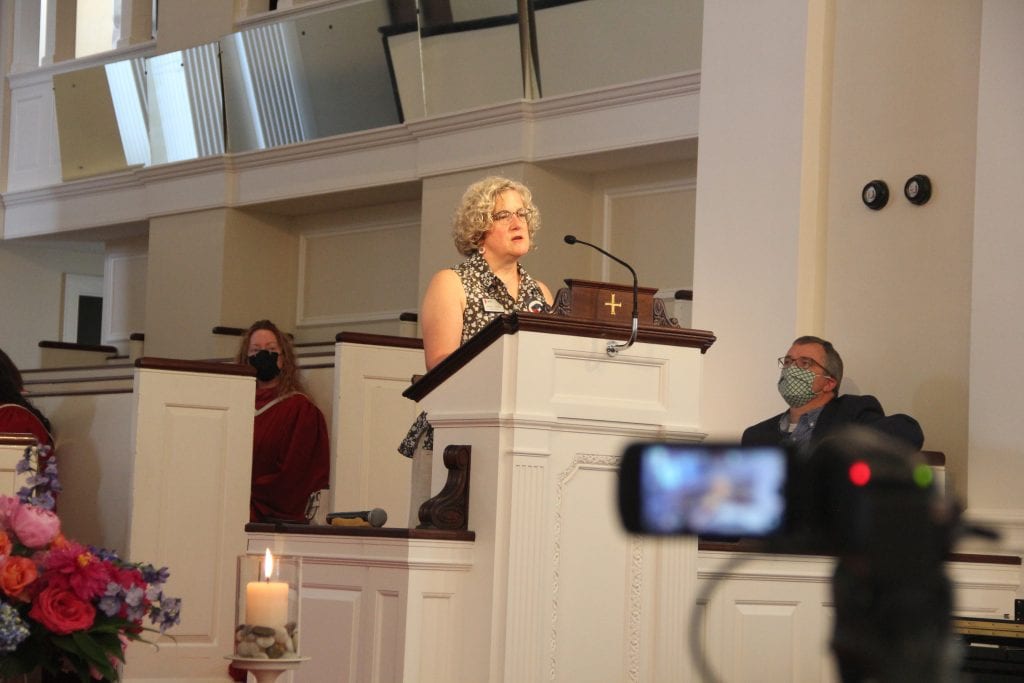
Jennifer deSimas speaks at the service prior to the dedication of Unity Green. Courtesy of First Church
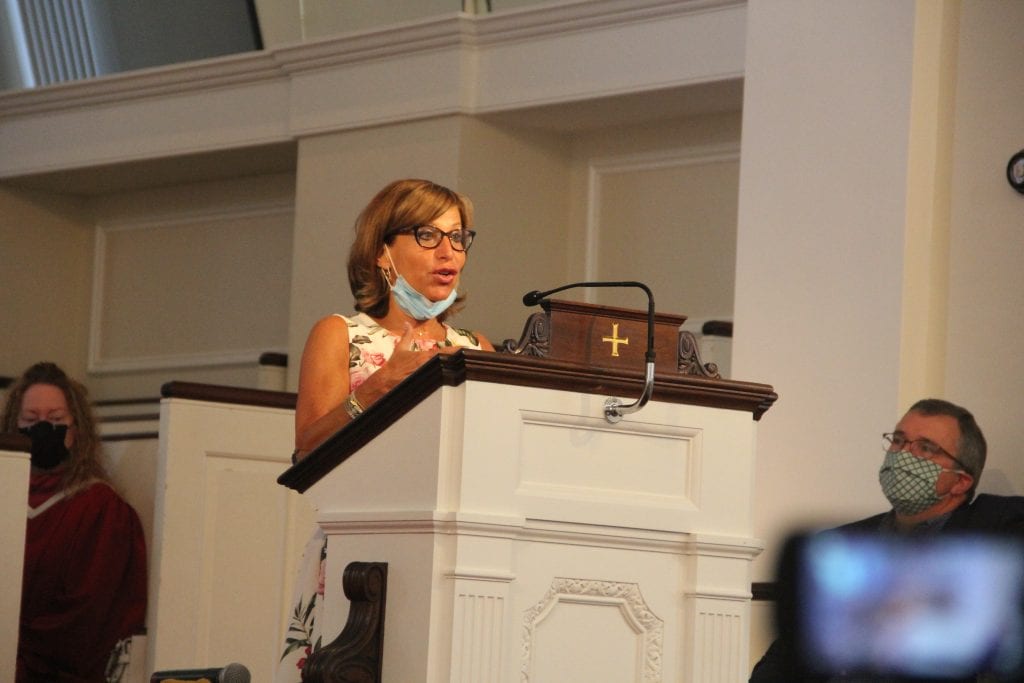
Mayor Shari Cantor speaks at the service prior to the dedication of Unity Green. Courtesy of First Church
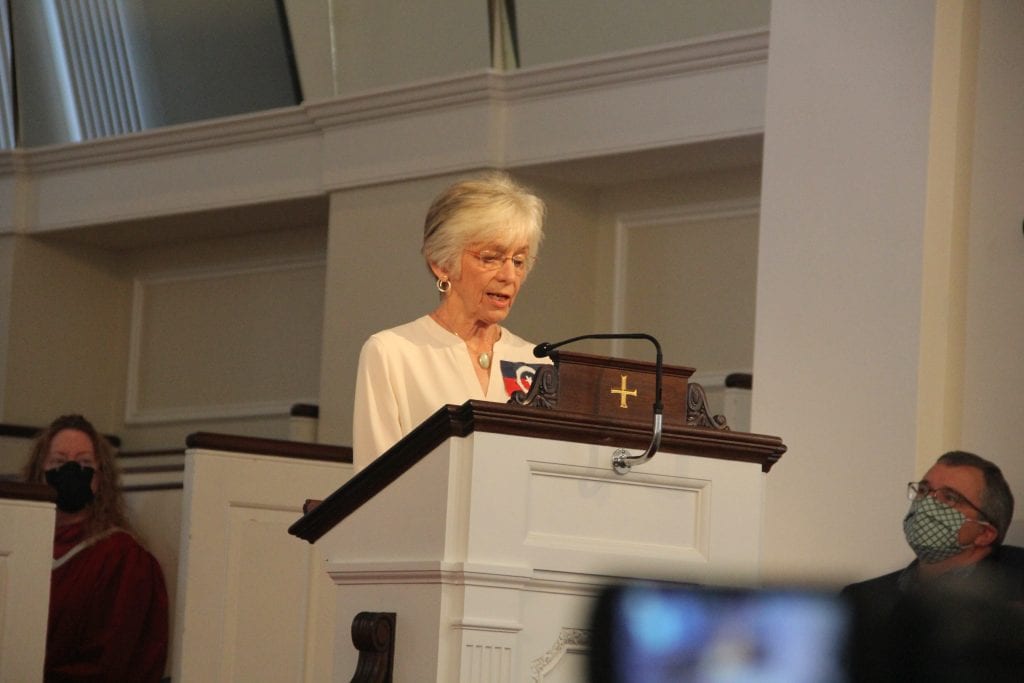
Dottie Stone, a direct descendant of Timothy Goodman, speaks at the service prior to the dedication of Unity Green. Courtesy of First Church
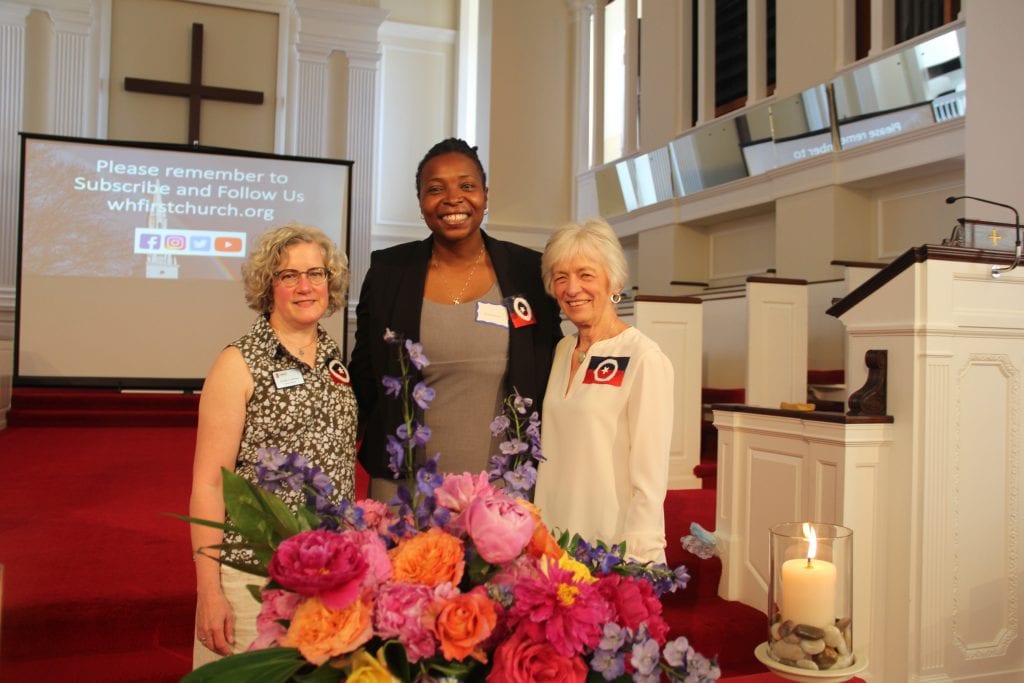
From left: Jennifer deSimas, Adrienne Billings-Smith, and Dottie Stone at First Church. Courtesy of First Church West Hartford.
Like what you see here? Click here to subscribe to We-Ha’s newsletter so you’ll always be in the know about what’s happening in West Hartford! Click the blue button below to become a supporter of We-Ha.com and our efforts to continue producing quality journalism.
 Loading...
Loading...




[…] West Hartford’s town green – that narrow triangle of land that splits the northbound and southbound lanes of South Main Street just south of Farmington Avenue and is the longtime site of banners and public gatherings – had previously been named Goodman Green, in honor of Timothy Goodman, who deeded it to First Church, which in turn has leased the land to the town since 1924. Recent research into the town’s history conducted as part of the Witness Stones project brought to light the fact that, along with some of West Hartford’s other prominent families for whom roadways and buildings have been named, Goodman was, indeed, a slaveholder. Continue reading. […]